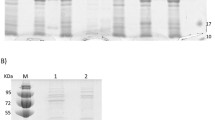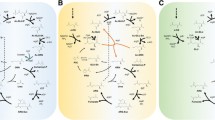Abstract
Aspartate kinase (AK) is a key enzyme involved in catalyzing the first step of the aspartate-derived amino acid biosynthesis, including L-lysine and L-threonine, which is regulated by the end-metabolites through feedback inhibition. In order to accumulate the end-metabolites in the host, the feedback inhibition of AK has to be released. In this study, a chimeric aspartate kinase, which is composed of the N-terminal catalytic region from Bacillus subtilis AKII and the C-terminal region from Thermus thermophilus, was evolved through random mutagenesis and then screened using a high-throughput synthetic RNA device which comprises of an L-lysine-sensing riboswitch and a selection module. Of three evolved aspartate kinases, the best mutant BT3 showed 160 % increased in vitro activity compared to the wild-type enzyme. Recombinant Escherichia coli harboring BT3 produced 674 mg/L L-lysine in batch cultivation, similar to that produced by the strain harboring the typical commercial widely used feedback resistant aspartate kinase AKCfbr from E. coli. The results suggested that this strategy can be extended for screening of other key enzymes involved in lysine biosynthesis pathways.




Similar content being viewed by others
Reference
Alper H, Moxley J, Nevoigt E, Fink GR, Stephanopoulos G (2006) Engineering yeast transcription machinery for improved ethanol tolerance and production. Science 314:1565–1568
Beninati S, Martinet N, Folk JE (1988) High-performance liquid chromatographic method for the determination of epsilon-(gamma-glutamyl) lysine and mono- and bis-gamma-glutamyl derivatives of putrescine and spermidine. J Chromatogr 443:329–335
Black S, Wright NG (1955) beta-Aspartokinase and beta-aspartyl phosphate. J Biol Chem 213:27–38
Cherepanov PP, Wackernagel W (1995) Gene disruption in Escherichia coli: TcR and KmR cassettes with the option of Flp-catalyzed excision of the antibiotic-resistance determinant. Gene 158:9–14
Curien G, Biou V, Mas-Droux C, Robert-Genthon M, Ferrer JL, Dumas R (2008) Amino acid biosynthesis: new architectures in allosteric enzymes. Plant Physiol Biochem 46:325–339
Datsenko KA, Wanner BL (2000) One-step inactivation of chromosomal genes in Escherichia coli K-12 using PCR products. Proc Natl Acad Sci U S A 97:6640–6645
Dietrich JA, McKee AE, Keasling JD (2010) High-throughput metabolic engineering: advances in small-molecule screening and selection. Annu Rev Biochem 79:563–590
Gibson DG, Young L, Chuang RY, Venter JC, Hutchison CA 3rd, Smith HO (2009) Enzymatic assembly of DNA molecules up to several hundred kilobases. Nat Methods 6:343–345
Gu P, Yang F, Kang J, Wang Q, Qi Q (2012) One-step of tryptophan attenuator inactivation and promoter swapping to improve the production of L-tryptophan in Escherichia coli. Microb Cell Fact 11:30
Huang KX, Scott AI, Bennett GN (1999) Overexpression, purification, and characterization of the thermostable mevalonate kinase from Methanococcus jannaschii. Protein Expr Purif 17:33–40
Kalinowski J, Cremer J, Bachmann B, Eggeling L, Sahm H, Puhler A (1991) Genetic and biochemical analysis of the aspartokinase from Corynebacterium glutamicum. Mol Microbiol 5:1197–1204
Kang Z, Wang Y, Gu P, Wang Q, Qi Q (2011) Engineering Escherichia coli for efficient production of 5-aminolevulinic acid from glucose. Metab Eng 13:492–498
Kato C, Kurihara T, Kobashi N, Yamane H, Nishiyama M (2004) Conversion of feedback regulation in aspartate kinase by domain exchange. Biochem Biophys Res Commun 316:802–808
Kind S, Becker J, Wittmann C (2013) Increased lysine production by flux coupling of the tricarboxylic acid cycle and the lysine biosynthetic pathway–metabolic engineering of the availability of succinyl-CoA in Corynebacterium glutamicum. Metab Eng 15:184–195
Kobashi N, Nishiyama M, Tanokura M (1999) Aspartate kinase-independent lysine synthesis in an extremely thermophilic bacterium, Thermus thermophilus: lysine is synthesized via alpha-aminoadipic acid not via diaminopimelic acid. J Bacteriol 181:1713–1718
Kotaka M, Ren J, Lockyer M, Hawkins AR, Stammers DK (2006) Structures of R- and T-state Escherichia coli aspartokinase III. Mechanisms of the allosteric transition and inhibition by lysine. J Biol Chem 281:31544–31552
Kuhlman TE, Cox EC (2010) Site-specific chromosomal integration of large synthetic constructs. Nucleic Acids Res 38, e92
Laemmli UK (1970) Cleavage of structural proteins during the assembly of the head of bacteriophage T4. Nature 227:680–685
Lerner CG, Inouye M (1990) Low copy number plasmids for regulated low-level expression of cloned genes in Escherichia coli with blue/white insert screening capability. Nucleic Acids Res 18:4631
Li M, Gu P, Kang J, Wang Y, Wang Q, Qi Q (2012) Extending homologous sequence based on the single gene mutants by one-step PCR for efficient multiple gene knockouts. Folia Microbiol (Praha) 57:209–214
Liang Q, Qi Q (2014) From a co-production design to an integrated single-cell biorefinery. Biotechnol Adv 32:1328–1335
Lynch SA, Gallivan JP (2009) A flow cytometry-based screen for synthetic riboswitches. Nucleic Acids Res 37:184–192
Mas-Droux C, Curien G, Robert-Genthon M, Laurencin M, Ferrer JL, Dumas R (2006) A novel organization of ACT domains in allosteric enzymes revealed by the crystal structure of Arabidopsis aspartate kinase. Plant Cell 18:1681–1692
Mironov AS, Gusarov I, Rafikov R, Lopez LE, Shatalin K, Kreneva RA, Perumva DA, Nudler E (2002) Sensing small molecules by nascent RNA: a mechanism to control transcription in bacteria. Cell 111:747–756
Muranaka N, Sharma V, Nomura Y, Yokobayashi Y (2009) An efficient platform for genetic selection and screening of gene switches in Escherichia coli. Nucleic Acids Res 37, e39
Nahvi A, Sudarsan N, Ebert MS, Zou X, Brown KL, Breaker RR (2002) Genetic control by a metabolite binding mRNA. Chem Biol 9:1043
Nishida H, Nishiyama M, Kobashi N, Kosuge T, Hoshino T, Yamane H (1999) A prokaryotic gene cluster involved in synthesis of lysine through the amino adipate pathway: a key to the evolution of amino acid biosynthesis. Genome Res 9:1175–1183
Nishiyama M, Kukimoto M, Beppu T, Horinouchi S (1995) An operon encoding aspartokinase and purine phosphoribosyltransferase in Thermus flavus. Microbiology 141(Pt 5):1211–1219
Ogawa-Miyata Y, Kojima H, Sano K (2001) Mutation analysis of the feedback inhibition site of aspartokinase III of Escherichia coli K-12 and its use in L-threonine production. Biosci Biotechnol Biochem 65:1149–1154
Sinha J, Reyes SJ, Gallivan JP (2010) Reprogramming bacteria to seek and destroy an herbicide. Nat Chem Biol 6:464–470
Sonntag K, Eggeling L, De Graaf AA, Sahm H (1993) Flux partitioning in the split pathway of lysine synthesis in Corynebacterium glutamicum. Quantification by 13C- and 1H-NMR spectroscopy. Eur J Biochem 213:1325–1331
Umbarger HE (1978) Amino acid biosynthesis and its regulation. Annu Rev Biochem 47:532–606
van Gulik WM, Heijnen JJ (1995) A metabolic network stoichiometry analysis of microbial growth and product formation. Biotechnol Bioeng 48:681–698
Wang HH, Isaacs FJ, Carr PA, Sun ZZ, Xu G, Forest CR, Church GM (2009) Programming cells by multiplex genome engineering and accelerated evolution. Nature 460:894–898
Winkler W, Nahvi A, Breaker RR (2002) Thiamine derivatives bind messenger RNAs directly to regulate bacterial gene expression. Nature 419:952–956
Yang J, Seo SW, Jang S, Shin SI, Lim CH, Roh TY, Jung GY (2013) Synthetic RNA devices to expedite the evolution of metabolite-producing microbes. Nat Commun 4:1413
Yanisch-Perron C, Vieira J, Messing J (1985) Improved M13 phage cloning vectors and host strains: nucleotide sequences of the M13mp18 and pUC19 vectors. Gene 33:103–119
Yoshida A, Tomita T, Kurihara T, Fushinobu S, Kuzuyama T, Nishiyama M (2007) Structural Insight into concerted inhibition of alpha 2 beta 2-type aspartate kinase from Corynebacterium glutamicum. J Mol Biol 368:521–536
Yoshida A, Tomita T, Kono H, Fushinobu S, Kuzuyama T, Nishiyama M (2009) Crystal structures of the regulatory subunit of Thr-sensitive aspartate kinase from Thermus thermophilus. FEBS J 276:3124–3136
Yugari Y, Gilvarg C (1965) The condensation step in diaminopimelate synthesis. J Biol Chem 240:4710–4716
Acknowledgments
This research was financially supported by grants from the National Natural Science Foundation of China (31370085), the National Basic Research Program of China (2012CB725202, 2011CB707405).
Conflict of interest
The authors declare that they have no conflict of interest.
Author information
Authors and Affiliations
Corresponding author
Rights and permissions
About this article
Cite this article
Wang, J., Gao, D., Yu, X. et al. Evolution of a chimeric aspartate kinase for L-lysine production using a synthetic RNA device. Appl Microbiol Biotechnol 99, 8527–8536 (2015). https://doi.org/10.1007/s00253-015-6615-0
Received:
Revised:
Accepted:
Published:
Issue Date:
DOI: https://doi.org/10.1007/s00253-015-6615-0




